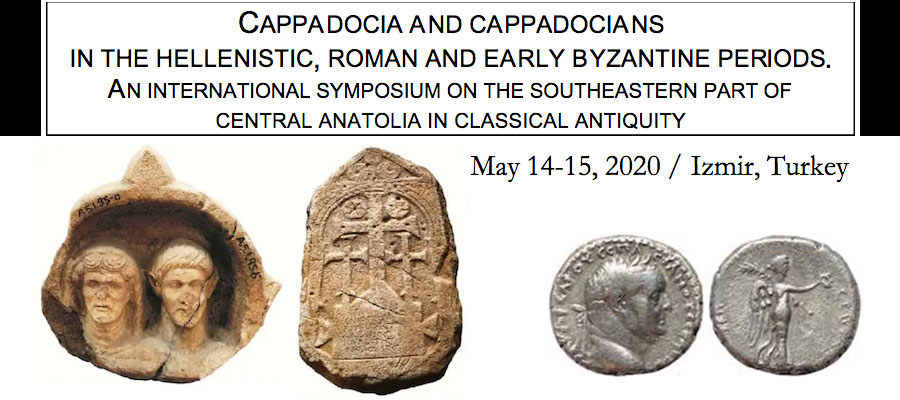Cappadocia and Cappadocians in Hellenistic, Roman and Early Byzantine Periods, Dokuz Eylul University, May 14–15, 2020
The Izmir Center of the Archaeology of Western Anatolia (EKVAM) announces the international symposium on the ancient region of Cappadocia in southeastern part of central Turkey. The symposium will take place on May 14-15, 2020 at the Dokuz Eylul University (DEU) in Izmir, Turkey.
Today Cappadocia covers Turkish provinces of Nevşehir, Kayseri, Kırşehir, Aksaray and Niğde as well as minor parts of Sivas and Kahramanmaraş. Herodotus reported Cappadocians as occupying an area stretching from Taurus Mountains to the vicinity of the southern Black Sea in the time of the Ionian Revolt in 499 B.C. In this sense Cappadocia was bounded in the south by the chain of the Taurus Mountains that separate these mostly plain landscapes from Cilicia, to the east by the upper Euphrates, to the north by Pontus, and to the west by Lycaonia and eastern Galatia. Today the name “Cappadocia” continues in use as an international tourism concept to define a region characterized by fairy chimneys (Turkish “Peri Bacaları”) and a unique historical and cultural heritage.
After ending the Persian Empire, Ariarathes I, a Persian aristocrat, became the king of Cappadocians between 332–322 B.C. Under Ariarathes IV Cappadocia came into relations with Rome in the early second century B.C., and the Roman emperor Tiberius reduced Cappadocia to a Roman province. In A.D. 314 Cappadocia was the largest province of the Roman Empire. In A.D. 371 the western part of the region was divided into Cappadocia Prima, with its capital at Caesarea (modern-day Kayseri) and Cappadocia Secunda, with its capital at Tyana. These two Cappadocian provinces became more important in the latter part of the fourth century A.D., as the Romans were involved with the Sasanian Empire over control of Mesopotamia. As Strabo considered Cappadocia as “almost a living part of Persia”, it still retained a significant Iranian character in this period. Therefore, Stephen Mitchell notes in the Oxford dictionary of late antiquity, “Many inhabitants of Cappadocia were of Persian descent and Iranian fire worship is attested as late as 465”. For most of the early Byzantine era Cappadocia remained relatively undisturbed by the conflicts in the area with the Sassanid Empire, but was a vital frontier zone later against the Muslim conquests. During the Byzantine period Cappadocia contains famous underground cities which have vast defense networks of traps throughout their many levels.
In scholarly research Cappadocia is known more through Byzantine mural paintings in cave churches at Göreme and Ürgüp from the eighth-ninth centuries to the 13th-century A.D., but the number of studies on Hellenistic and Roman Cappadocia is rather limited. The aim of this symposium is therefore to report on the state of research concerning Cappadocia between the late-fourth century B.C. and mid-seventh century A.D. We warmly invite contributions by scholars and graduate students from a variety of disciplines related to this region. Intended to bring together scholars of archaeology, history, historical geography, epigraphy and other related disciplines in ancient Anatolian studies to discuss a range of issues concerning this region’s archaeology and history, this symposium should be an excellent opportunity to increase our knowledge about this region.
The following theme groups are the main questions of the symposium which are prescriptive:
- Archaeological field projects and museum studies in Cappadocia,
- Cappadocia in ancient mythology,
- Cappadocia during the Iron Age,
- Lydians, Achaemenid Persian Empire and their relations to Cappadocia during the sixth and fifth centuries B.C.,
- The use of höyüks and tumuli during the Hellenistic, Roman and Early Byzantine periods in Cappadocia,
- The Royal Road and Cappadocia,
- The Kingdom of Cappadocia in the Hellenistic period,
- Cappadocia and Seleucids as well as other Hellenistic kingdoms,
- Zoroastrianism, Magism, Mazdeism and Mithraic worshipping in Hellenistic and Roman Cappadocia,
- Cappadocia and Cappadocians in Herodotus’ and Strabo’s records,
- Historical geography and settlement patterns in Hellenistic, Roman and late Roman-early Byzantine Cappadocia,
- Important Cappadocian cities: Caesarea and Tyana etc.,
- Geographical, cultural and ethnic borders of Cappadocia,
- Relationships between Cappadocia and neighbouring regions,
- Roads, routes and population in Cappadocia,
- Language, script and epigraphy in Cappadocia,
- Coinage of the Kingdom of Cappadocia and Roman Cappadocia,
- Aspects of Romanisation through art and architecture in Cappadocia,
- Military archaeology in Roman Cappadocia,
- Forms of Christian presence in Roman and early Byzantine Cappadocia,
- Cappadocia Prima, Cappadocia Secunda and late Roman provincial administration around Cappadocia,
- The Cappadocian Fathers of the fourth century A.D.,
- Episcopal sees of the late Roman province of Cappadocia,
- Cappadocian underground cities and their archaeology,
- Ethno-cultural landscape of ancient Cappadocia,
- Miscellanea.
On these themes and questions, all approaches and methods susceptible to bring some progress to our current knowledge are of course welcome: archaeology, ancient history, historical geography, epigraphy, numismatic, history of art, cultural anthropology etc.
English is the official language of the symposium.
